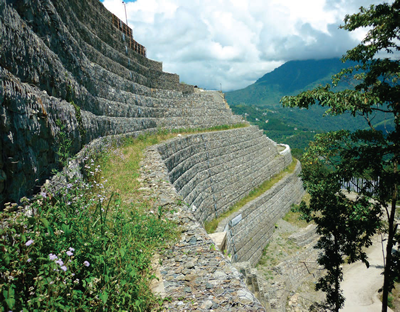
On 3 March 2015, the International Geosynthetics Society (IGS) UK Chapter will offer a joint meeting of the IGS UK and Yorkshire Geotechnical Group. Presenter Dave Crowther (Maccaferri Ltd.) will present on the enormous, award-winning Pakyong Airport MSE wall in Sikkim, India. The presentation, “The tallest reinforced soil structure in the world?”, will profile 550m wide, 1.7 km long, and nearly 75m high wall.
DOWNLOAD AN EVENT FLYER
(Scroll down for a Sikkim video interview.)
In the event flyer, the organizer’s note that the project emerged from Airports Authority of India’s (AAI) requirement for airport buildings and a runway “to be carved from the mountainous topography using massive geotechnical cut and fill engineering works in this seismic area.”
The geosynthetic-reinforced Sikkim project was honored with a Ground Engineering “Best International Project” award in 2012.
David Crowther is a 40-year veteran of construction and engineering. Since 2005, he has held design and technical management positions with Maccaferri.
IGS/Yorkshire Geotechnical Group
Joint Meeting
3 March 2015
18:00 – 18:30
York Engineers Triangle, Cinder Lane off Leeman Road, York, YO26 4AB
Geosynthetica’s Elizabeth Peggs interviewed engineer Pietro Rimoldi about this project during a conference in 2013:
In a 2013 article, engineers describing the site wrote:
Sikkim airport project lies in seismic zone IV, classified as severe seismic intensity zone according to Indian norm. For 70+m high structures located in seismic zone IV, the use of hybrid MSE structure was highly necessitated. Seismic design has been carried out as per pseudo static method described in FHWA manual. Reduction factors have been considered in calculating the long term design strength of primary geogrid reinforcement from its short term ultimate tensile strength. Seismic design has be carried out for considering load factors = 1.0 for all the loads. For seismic condition the target factor of safety for respective mode of failure is 75 % of static condition as per the guide lines of FHWA….
On 18 September 2011, an earthquake of magnitude 6.9 was felt across northeastern India (Sikkim), Nepal, Bhutan, Bangladesh and southern Tibet…. The peak ground acceleration for the earthquake of 6.9 on Richter scale would be 0.354 g. Horizontal seismic coefficient can be worked out as half of ground acceleration. Seismic analyses of full height structure with horizontal seismic coefficient of 0.175 shows that factor of safeties are just more than 1.0….It is worth to note that the hybrid MSE structure have withstood an earthquake of 6.9 magnitude with no visible damage.
DOWNLOAD AN EVENT FLYER
SEE ALSO:











